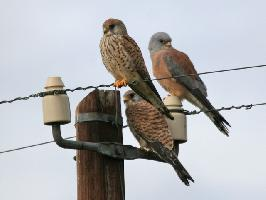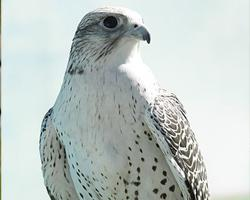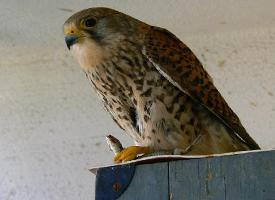
Poids et mesures
| Longueur | de 29 à 31 cm |
|---|---|
| Envergure des ailes | de 63 à 72 cm |
Statut de conservation
| Menacé |
Description de l'animal
The Lesser Kestrel (Falco naumanni) is a small, graceful bird of prey belonging to the falcon family, Falconidae. This species is closely related to the more widespread Common Kestrel, but it is distinguishable by its slightly smaller size, different plumage patterns, and distinct behavior. Lesser Kestrels exhibit remarkable adaptations for hunting and a fascinating lifecycle that has intrigued ornithologists and nature enthusiasts alike.Adult Lesser Kestrels typically measure between 27 to 33 centimeters in length, with a wingspan ranging from 63 to 72 centimeters. They possess a slender build, with long, pointed wings and a long tail that enhance their flying and maneuvering capabilities. Males and females exhibit sexual dimorphism in their plumage. The male Lesser Kestrel has a slate-grey head and tail, with a rufous back and a spotted black pattern that provides excellent camouflage against the rocky and grassy landscapes of their habitats. Their underparts are creamy-white with black spots. Females, on the other hand, have a more uniform brown coloration throughout their bodies with less distinct spotting and barring, which helps in camouflaging them especially during nesting.
One of the most distinctive features of the Lesser Kestrel is its diet. Unlike many birds of prey that have a diverse diet, Lesser Kestrels predominantly feed on insects, making them one of the few falcon species with such a specialized diet. Their prey includes grasshoppers, beetles, and other small insects, which they often catch in flight with remarkable agility and precision. This diet plays a crucial role in their migration patterns and breeding success, as they rely on abundant insect populations in their breeding and wintering grounds.
Lesser Kestrels are migratory birds, spending the breeding season in the Mediterranean region, including parts of southern Europe, northern Africa, and western Asia, before migrating to sub-Saharan Africa to spend the winter. During the breeding season, they prefer open countryside with low vegetation, such as farmlands, grasslands, and steppes, where they nest in colonies. An interesting aspect of their nesting behavior is their preference for using old buildings, ruins, and cliff ledges, as well as tree holes, for nesting sites, rather than constructing nests of their own.
The species faces several threats, including habitat loss due to agricultural intensification and urbanization, pesticide use that reduces their insect prey, and climate change that affects their migratory patterns and breeding success. Conservation efforts for the Lesser Kestrel include habitat protection and restoration, monitoring populations, and reducing pesticide use in their habitats.
Despite these challenges, the Lesser Kestrel remains a symbol of the wild, open landscapes it inhabits, and a reminder of the intricate connections within ecosystems. Its graceful flight, specialized hunting skills, and communal nesting habits make it a fascinating subject of study and an important species for conservation efforts.
Carte de répartition

Animaux similaires
Nouvelles photos d'animaux
Top 10 des animaux
- Dolphin gull (Leucophaeus scoresbii)
- Diana monkey (Cercopithecus diana)
- Moustached guenon (Cercopithecus cephus)
- Galápagos tortoise (Geochelone nigra complex)
- Japanese macaque (Macaca fuscata)
- Stone loach (Barbatula barbatula)
- Russian tortoise (Testudo horsfieldii)
- Greek tortoise (Testudo graeca)
- Common flying dragon (Draco volans)
- Vendace (Coregonus albula)


